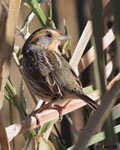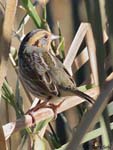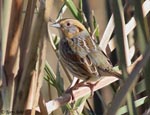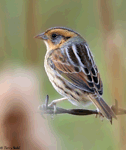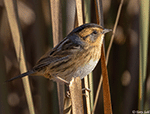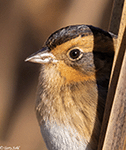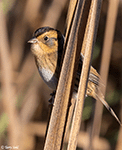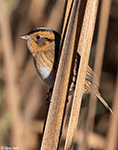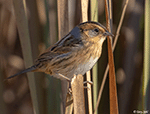| Length: 4.75 inches | Wingspan: 7.25 inches | Seasonality: Migrant / Summer |
| ID Keys: Gray cheek surrounded by buffy-orange, buffy breast and sides with darker streaks, white belly, gray central crown stripe | ||
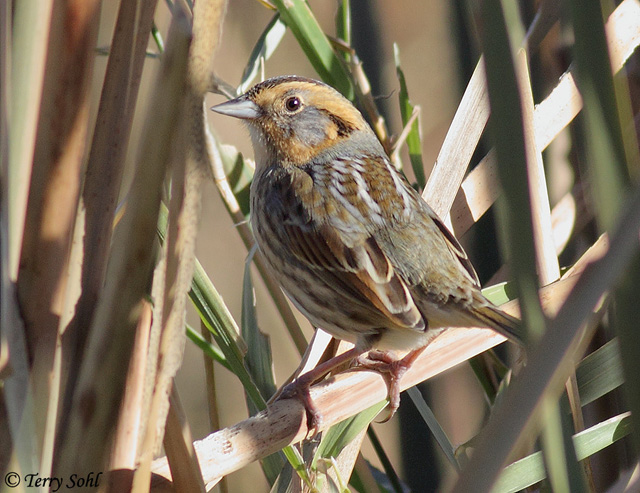 The Nelson's Sparrow and the
Saltmarsh Sparrow were only recently
split into two species, having once been both labeled the "Sharp-tailed
Sparrow". The Nelson's is unusual in several ways. Their
breeding distribution is oddly disjunct, with an interior population in the
Northern Plains of the U.S. and south-central Canada, and coastal populations on
southern Hudson Bay and in the New England area. Their breeding behavior
is also unusual, in that both sexes are extremely promiscuous and fail to form
pairs. Males will sing their mating song, but will breed with any female
that is amenable. Females raise the young alone, and will also mate with
multiple males.
The Nelson's Sparrow and the
Saltmarsh Sparrow were only recently
split into two species, having once been both labeled the "Sharp-tailed
Sparrow". The Nelson's is unusual in several ways. Their
breeding distribution is oddly disjunct, with an interior population in the
Northern Plains of the U.S. and south-central Canada, and coastal populations on
southern Hudson Bay and in the New England area. Their breeding behavior
is also unusual, in that both sexes are extremely promiscuous and fail to form
pairs. Males will sing their mating song, but will breed with any female
that is amenable. Females raise the young alone, and will also mate with
multiple males.
Nelson's Sparrows are named after Edward William Nelson, a naturalist who did extensive work in the western US and Mexico, and who also served as the president of the American Ornithological Union for a time.
Habitat:
During the summer breeding season, they are found in freshwater marshes with abundant marsh grasses. They are primarily found in saltwater marshes during the winter.
Diet:
Most of the summer diet is insects and spiders. Insects, spiders, marine worms, snails, and other small invertebrates continue to make up much of the diet in the winter along the Atlantic and Gulf coasts, but they will also feed on seeds of grasses and marsh plants.
Behavior:
Usually forages along or near the ground, picking up food items from the ground, foliage, water, and sometimes probing in mud. Males will sing both from perches and in flight during the summer breeding season.
Nesting:
June and July. The nest of a Nelson's Sparrow is a cup built of grasses, usually placed on the ground. The female lays between 3 and 5 eggs, and she alone incubates them. She also is the only parent to feed the young after the eggs hatch.
Song / Call:
The song of a Nelson's Sparrow is a wheezy hissing p-tsssssshhhuk. They also have a muted metallic tik call. Unlike some species that often perch in a higher and more visible location when singing, male Nelson's Sparrows often sing from the same dense wetland vegetation where they nest, making them a species that is often difficult to observe. They sing both day and night.
- Click here to hear the song of a Nelson's Sparrow1
- Click here to hear the short call of a Nelson's Sparrow2
- Click here to hear another song of a Nelson's Sparrow3
Migration:
An unusual summer distribution, with populations in the extreme Northern Plains and south-central Canada, and a disjunct population along the shores of Hudson Bay and in the New England area. They winter along the Atlantic and Gulf coasts where they may come into contact with their close cousin the Saltmarsh Sparrow. In South Dakota, Nelson's sparrows are a rare breeding bird in the northeastern part of the state, and a rare migrant in eastern South Dakota.
Interactive eBird map:
Click here to access an interactive eBird map of Nelson's Sparrow sightings
Similar Species:
In South Dakota we're fortunate to have a few other beautiful sparrow species that could potentially be confused with a Nelson's Sparrow. Another out-of-state species is also very similar.
- LeConte's Sparrow - LeConte's Sparrows are similar in several ways to Nelson's Sparrows in South Dakota. They both have a limited breeding range in the state, in the northeastern part of South Dakota. They both are very similar in appearance. And, both can be difficult to see given their preference for dense herbaceous vegetation. Habitat is one clue, as LeConte's Sparrows are sometimes found in drier habitats (particularly in migration through the state), while Nelson's Sparrows are primarily found around wetland vegetation. In terms of appearance, the easiest way to differentiate between them is the nape, as LeConte's Sparrows have a streaked gray nape, while Nelson's Sparrows have a plain gray nape. The stripe down the center of the crown is also whiter on a LeConte's Sparrow and a duller gray on a Nelson's Sparrow.
- Grasshopper Sparrow - Another small sparrow found in South Dakota, Grasshopper Sparrows are more widely distributed, breeding in suitable grassland habitats throughout the state. That habitat is another clue, as Grasshopper Sparrows are primarily found in shortgrass prairies, while Nelson's Sparrows are most often found in and around wetland vegetation. Overall, Grasshopper Sparrows are less colorful, lacking the buffy orange colors on the head, flanks, and upper breast on a Nelson's Sparrow. Grasshopper Sparrows also lack the streaking on the underside of a Nelson's Sparrow. Grasshopper Sparrows also usually have a yellow spot in front of the eye that's lacking on a Nelson's Sparrow.
- Saltmarsh Sparrow - Not an identification challenge in South Dakota, as Saltmarsh Sparrows are found in a limited range along the eastern coast of the United States. Saltmarsh Sparrows are generally more brightly colored on the head than a Nelson's Sparrow, but lack the buffy orangish color on the chest of a Nelson's Sparrow. There is a reason this species is an identification challenge...Nelson's Sparrows and Saltmarsh Sparrows used to be considered one species until recently, the "Sharp-tailed Sparrow".
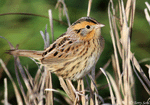 |
 |
 |
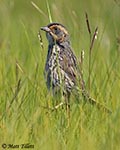 |
| Leconte's Sparrow | LeConte's Sparrow | Grasshopper Sparrow | Saltmarsh Sparrow |
Conservation Status:
They are possibly vulnerable to habitat loss due to draining of wetlands, but populations are currently holding their own. They are still found across a modestly broad geographic area and are common in some parts of that range. The IUCN lists the Nelson's Sparrow as a species of "Least Concern".
Further Information:
Photo Information:
September 26th, 2012 - "Bucher Prairie", Minnehaha County, South Dakota - by Terry Sohl
Audio File Credits:
- 1Martin St-Michel. Recorded in Quebec on July 3rd, 2017. Original recording and information available from xeno-canto.
- 2Paul Marvin. Recorded in San Diego County, California on January 3rd, 2018. Original recording and information available from xeno-canto.
- 3Patrick Turgeon. Recorded in Saskatchewan on June 12th, 2013. Original recording and information available from xeno-canto.
| Click on the map below for a higher-resolution view |
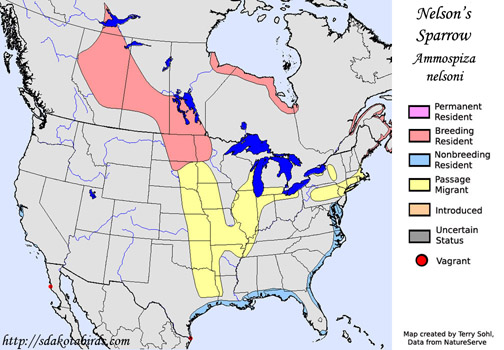 |
| South Dakota Status: Rare migrant in the eastern part of the state, and rare breeder in the northeast. |
Additional Nelson's Sparrow Images
Click for a higher-resolution version of these photos
